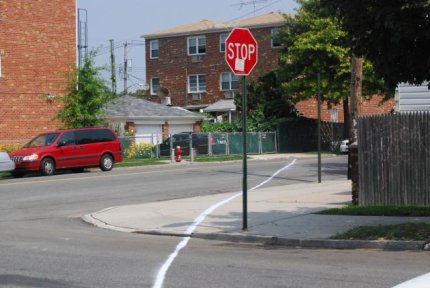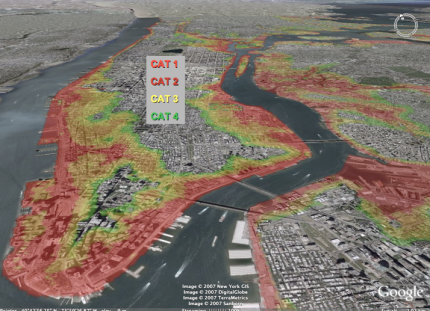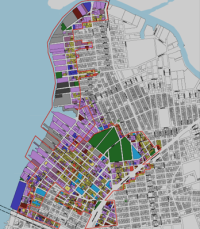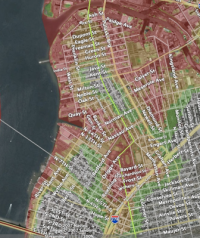A City by the Sea -- or Under It?

Columbia University promises that its new campus in West Harlem will boast tree-lined blocks, new outdoor cafes and glass-walled buildings where arts and research will flourish. There's one problem, though, according to Klaus Jacob, a special research scientist at the Lamont-Doherty Earth Observatory of Columbia University: It could all be underwater.
Under Jacob's worst case projections, more than half of the new campus could end up submerged by water if hit by the right storm.
Columbia's planners could have minimized the risk of damage, Jacob argues. Instead, they plan to build one large basement that connects the entire 17-acre campus, meaning that if one building floods, they all flood. Furthermore, he said, by locating the new campus' power plants underground, the school puts its energy source at risk.
The Columbia expansion is not the only large-scale project in New York in danger of flooding. With climate change promising more violent and frequent storms, much of the planned and existing development in the city could face severe floods,
Using a slide show he has developed - a kind of New York City centric "Inconvenient Truth" - Jacob is promoting the need to plan for the effects of climate change. While they may not have seen the presentation, many people are concerned. According to a survey released this week by Columbia and Yale Universities, 69 percent of New Yorkers believe "it is likely that parts of New York City will need to be abandoned due to rising sea levels over the next 50 years."
So how is the city preparing? Ron Shiffman, former city planning commissioner, has not seen much indication they are. "I think it's a big question mark," Shiffman said. "They say they're working on it, but I have yet to see anything."
Any decisions made in New York City about the best way to incorporate risks from climate change into land use plans would not be implemented until after Mayor Michael Bloomberg leaves office. That would be after the city has undertaken what Bloomberg has called "the most fundamental and geographically significant changes since the 1960s" -- and a redevelopment plan that, in the view of many, does not address the new reality of a wetter, warmer New York.
THE GROWING RISKS
With some 600 miles of waterfront, New York City is particularly vulnerable to storm surges and rising seas -- and to the effects of a warmer climate.
The Union of Concerned Scientists estimates temperatures will rise between four and thirteen degrees Fahrenheit in the next 90 years. Higher temperatures will increase the intensity and frequency of storms, lead to more rainfall during the winter due to less snow and create rising sea levels, all of which will make flooding more common and severe. Even under an optimistic scenario, the group predicts that the kind of flood the city now expects once every 100 years could occur an average of every 22 years by the turn of the century.
Over the next 80 years, sea levels around New York City could rise by 11.8 to 37.5 inches, according to calculations by the U.S. Global Change Research Program. As a result, "flooding by major storms would inundate many low-lying neighborhoods and shut down the metropolitan transportation system with much greater frequency," said a paper by the Columbia University Center for Climate Systems. Given this, the paper continued, many areas would face flooding from a Category 3 hurricane, including "the Rockaways, Coney Island, much of southern Brooklyn and Queens, portions of Long Island City, Astoria, Flushing Meadows-Corona Park, Queens, lower Manhattan, and eastern Staten Island from Great Kills Harbor north to the Verrazano Bridge."

The city's infrastructure could take a particularly heavy hit, according to Matthew Bowman, head of the Storm Surge Research Group at Stony Brook University. This, he has said, "includes subway entrances that are close to sea level, tunnels and their air and vent shafts, subway track and signal systems, bridge access roads, small bridges, airports, port freight-handling facilities, water pollution control plants and their tide-gate regulators, combined sewer outfalls, landfills, solid-waste transfer stations, pipelines, power plants, and buildings in areas with high property values and dense population."
Overall, Bowman figures, "In the future, a weaker storm will do the same damage that a severe storm does today."
How will this be experienced in different parts of the city?
Ground Zero
Storms could bring 10 foot-surges to lower Manhattan, affecting much of the new development planned in and around Ground Zero. The World Trade Center memorial could flood "unless they have special flood gates to seal it off," Vivien Gornitz, a special research scientist for NASA Goddard Institute for Space Studies at Columbia University, told the Downtown Express.
The Lower Manhattan Development Corp. has dismissed the danger. "The designs would be resistant to those types of flooding dangers," a senior advisor, Victor Gallo, has said.
The structures in the trade center site will be set in a foundation popularly referred to as the bathtub. "This bathtub, with its memorial, with its museum and several other structures inside it and adjacent to it, could very well be flooded. Now, to pump out a whole bathtub with all those things - I think is not what we were looking forward to," Jacob told National Public Radio.
The transportation hub being built on Fulton Street also is vulnerable to flooding because of its low elevation, Jacob said.
Nearby neighborhoods, such as Greenwich Village and Little Italy, also are at very low elevations. Many buildings in these areas have masonry foundations, making them particularly vulnerable to damage, Joe Tortorella, a structural engineer and a member of the Disaster Preparedness Task Force of the American Institute of Architects, said in the Times.
In a severe storm, "if the water moves fast enough and recedes fast enough, there could be scouring like a tide that takes sand with it on the beach. As the water recedes, it pulls silt out and could undermine the building," Tortorella said. "It could be a disaster of epic proportions in New York for the smaller buildings."
Brooklyn Waterfront

Areas of the Greenpoint-Williamsburg waterfront slated for development -- which aim to bring tens of thousands of new residents -- are at risk of being flooded by a hurricane, according to the city's own maps. Sewers in Greenpoint already cannot deal with the rainwater from severe storms, such as those of last July and August.
Writing in the Brooklyn Paper, Tom Gilbert, a writer and historian who lives in the neighborhood, described driving on Morgan Avenue at the height of a major storm last July: "A river of water as high as my hubcaps roaring down the street and cascading over the sidewalk into basements, as panicked residents ran out of their houses."
Such a scene, he continued, reinforces "continuing doubts about how well the infrastructure of North Brooklyn is handling the building boom of the past five years and how well city and state government are managing this explosive growth."

Much of the new development "will occur along the East River waterfront, which is subject to flooding from storm surges. New construction will result in significant changes to the floodplain that may reduce its capacity for flood retention or alter stormwater flow characteristics," said Brooklyn Community Board One's Rezoning Task Force in comments on the draft of an Environmental Impact Statements on rezoning the area to accommodate more development.
For its part, the environmental impact statement generally says all new structures in the area should meet existing city and Federal Emergency Management Agency requirements. But it notes, "the proposed action would not involve any direct public funding for flood prevention or erosion control measures."
Queens
The changing climate threatens existing developments as well. The vast majority of damage resulting from this summer's flash floods were in Queens. After that storm, an underpass in Glendale was covered with 10 feet of water, raw sewage was forced up through people's toilets and sinks in Queens Village, and the tracks at Long Island Railroad's Bayside station were immersed.
Much of the area is on land that is low lying and getting even lower. Emily Lloyd, commissioner of the Department of Environmental Protection, has said that the water table in southeast Queens has risen 30 feet in 20 years, and now sits "just below the surface."
In March, the city created a Flood Mitigation Task Force to identify hotspots for flooding throughout the borough by March. Some progress has begun, and last month the Department of Environmental Protection announced a six-year effort to build a drainage pipe for Whitestone.
FACING THE PROBLEM
No matter what government, business and individual citizens do, a flash flood, is difficult to deal with. "All of the underground infrastructure basically becomes a drainage ditch," said Rae Zimmerman, professor of planning and public administration at New York University. But, she added, much more could be done to prevent these problems.
Task Forces and More Task Forces
Much of the planning to prepare for the effects of climate change will begin under the auspices of the myriad taskforces and advisory boards that are being formed as part of PlaNYC, the city's long term sustainability plan .
The administration is creating a multi-agency Climate Change Task Force to figure out how to protect the city's infrastructure. Most of that - including the subways, electricity and gas distribution systems and communications network - is underground.
The Department of Buildings is creating its own taskforce, and part of its goal is to develop amendments to the building codes to make buildings more storm resistant and inhabitable even without power.
Better Sewers
Perhaps the first problem the city needs to address is its sewers, which cannot cope with even normal amounts of rain. PlaNYC laid out a number of pilot studies for strategies to keep water out of the system in the first place. But after the subway flooding in August, the City Council took a more aggressive approach and passed legislation mandating a sustainable stormwater management plan by October. Another bill would mandate that capital projects paid for with a significant amount of city money retain, reuse and treat stormwater to keep it out of the sewers.
While experts support the new law, they consider it only a first step and are waiting for details to emerge. "The new law is definitely going to take the city in the right direction," says Larry Levine, a water expert at the Natural Resources Defense Council. "But just how quickly and effectively remains to be seen."
Housing
Providing temporary housing for a large, displaced population will take substantial planning. In beginning that effort, the city's Office of Emergency Management recently published the results of its design competition to create post-disaster housing.
The 10 winners of this competition all create homes that could be easily built and arranged to promote community. Each has been awarded $10,000 to further develop their projects, which will then be displayed again in May.
One would build homes on a series of barges attached to the mainland by threads that carry electrical cables and water and sewer lines. The barges would remain after reconstruction to provide parks and help restore a shoreline ecology decimated by centuries of industrialization. Another would use the debris from a disaster to create piers for new housing to be built upon.
Providing Insurance
Since 2004, 50,000 residents in the metropolitan area have had their homeowner's insurance policies canceled because of the risk of floods. Allstate, State Farm and Liberty Mutual now refuse to write new policies in the city because of the danger, according to the New York Times.
To help reduce rates in the city for flood insurance, which is issued by the federal government, PlaNYC wants the city to join a federal plan called the Community Rating System, which calls for lower insurance premiums in communities whose flood management plans exceed federal standards.
GRASSROOTS EFFORTS
Many experts believe that for any of these ideas to work, the public must play a key role. "Public support, or even public pressure" is needed to get city officials to confront the changing circumstances, said Susanne Moser, a scientist at the National Center for Atmospheric Research who coauthored a report on this issue. "That means the public needs to know what to support, what to oppose .... It's important for citizens not to leave policy-making or policy-implementation only up to influential interests."
The city has started a pilot program to engage communities to help plan for the possible effects of climate change and to share their expertise about their neighborhood with officials. The first effort is in Sunset Park, Brooklyn, in partnership with UPROSE, a local Latino community group. The organization has held three planning discussions with a host of local residents with a goal of creating a climate change adaptation plan that reflects the community's thinking.
"We are looking at planning efforts, which may be different when you put the climate change lens on them," says Elizabeth Yeampierre, the group's executive director. "But we don't really know how the city is going to respond to this in the end. The problem is really the cost: What can or can't the city afford to do."
UPROSE hopes to have developed a plan by this spring.
WHAT OTHER CITIES ARE DOING
Although New York has begun confronting the effects of climate change, other governments in the nation are farther along in the process.
Kings County, Washington, which includes Seattle and its legendary rainfall, has made climate adaptation an integral part of its planning process. The county government's overall climate plan includes the Flood Control Zone District, an agency that builds and improves flood management infrastructure, buys back property at risk of flooding and limits new development that would contribute to flood risks.
King County Executive Ron Sims, the county's global warming team and the Climate Impacts Group at the University of Washington have written a roadmap for local, state and regional governments that wish to include climate adaptation in their planning.
"There are still many people who are reluctant to talk about specific adaptation or preparedness policies. But as responsible public leaders, we cannot afford the luxury of not preparing," Sims wrote in the introduction to the guide.
The map is being distributed through the International Council for Local Environmental Initiatives, which has started a new program called Climate Resilient Communities.
One of the earliest places to become a climate resilient community is Keene, New Hampshire, a city of about 23,000 people. Its Climate Adaptation Action Plan would identify areas with a 2 percent or greater chance of flooding every year and prevent future development in those areas.
It may come as no surprise that Keene is ahead of the curve. The city was ravaged by a storm of such intensity in 2005 -- one it is only expected to experience once every 500 years.
LOOKING FOR ANSWERS
Given that New York is an old and crowded city built on islands and along shorelines, experts agree there are no easy answers to protect its buildings and systems from flooding.
The subway and the sewers point out the complexity of the problem. Any water taken out of subways tunnels during a severe storm, such as last summer's, ends up in the sewer system, overtaxing that infrastructure. "You solve one problem and you create another," Madan Naik, chief structural engineer of New York City Transit, has said.
Others have envisioned barriers that will literally hold back the sea, such as those used in the Netherlands. In particular, some scientists have envisioned a system of three barriers that would operate together: one at the the Narrows at the mouth of New York Harbor between Staten Island and Brooklyn, another across the Upper East River and the third at the mouth of the Arthur Kill between New Jersey and Staten Island.
Jacob offers anther solution -- one that seems almost impossible to implement in a growing city of 8 million always searching for more space. He called for simply pulling back from low-lying, flood prone areas. "That," he has said, is the "price to be paid for pumping carbon dioxide into the atmosphere."
Â
Opening the City's Greenmarkets

Everyone loves a farmer's market. From the bright, eye-catching crimson of cherries in July, to the subtle smell of cinnamon apple cider in January, they offer sensory delights during all seasons. Unfortunately, until recently, lower income New Yorkers often had limited access to the city's greenmarkets.
Residents of the city's less affluent communities have long complained that finding healthy foods, especially fresh produce can pose a real challenge in their neighborhoods. Now a series of initiatives by the city and state hope to make it easier for more New Yorkers to shop at farmer's markets.
Payment Problems
In 1999, the state government stopped the distribution of paper food stamps and joined the federal transition to Electronic Transfer Benefit, or EBT, cards. While this change was much more convenient for large supermarkets, the city's farmer's markets, which are open-air, had no access to the outlets necessary to process the electronic payments.
To address this, in 2001, the state Department of Agriculture and Markets and the Farmers' Market Federation of New York launched "The Wireless EBT Project," which provided wireless EBT machines to some individual farmer's market vendors. Although consumers generally applauded the effort, the machines often experienced delays of 20 to 30 second when processing the payments, a problem in the markets, where vendors rely on many small, quick sales.
In response, the project changed its format. Rather than give wireless terminals to individual vendors, some markets received a central terminal. Consumers swiped their benefit cards in exchange for wooden tokens, which they can then spend them as cash in that particular market. At the end of the day, farmers handed in their tokens to the manager for reimbursement. Although this made it easier for people to use EBTs, not every market could afford the central terminal or to have a manager to perform these duties.
In May 2006, City Council President Christine Quinn proposed allocating $81,200 to buy EBT machines for individual farmers, with the purpose of providing food stamp recipients with greater access to greenmarkets. Two markets received central EBT terminals, and two more were given EBT terminals for each vendor. Signs in English and Spanish informed consumers that food stamps were accepted.
Producing Results
Two years later, it seems that almost no one has anything bad to say about the EBT machines being used in the markets. Electronic benefits sales have increased from $1,000 in 20005 to $40,000 last year, according to Michael Hurwitz, greenmarket director for the Council on the Environment, which operates the greenmarket program. The terminals, he said, "have brought more money to farmers, and customers are thrilled that they can use them."
"There's been a tremendous positive response from customers," said Bob Lewis, the chief marketing representative for the state Department of Agriculture and Markets. "The advantage is that then the farmer doesn't need to have a terminal, so there's no account which requires a monthly fee. The other thing is that the farmer doesn't need to be authorized with food stamp program, so there's very little paperwork involved."
The East New York Farms farmer's market, which, unlike the greenmarkets, is not operated by the Council on the Environment, has accepted Electronic Benefits Transfers for three years. "I've noticed that over time it becomes more and more frequent. "Over time, I've noticed that the use of EBTs has become more frequent," said Jonah Braverman, urban agriculture coordinator for East New York Farms.
Adding Markets
Making it easier to pay at the market only goes so far. Before they can use the new machines customers have to be able to get to the market in the first place. That called for placing markets in more neighborhoods.
In June 2006, the Mayor's Community Affairs Unit, the Council on the Environmental Affairs of New York City and City Council decided to open 10 new greenmarkets in underserved neighborhoods in the South Bronx, North and Central Brooklyn, and Harlem. All were up and running by that August of that year. Two of the locations are in Harlem, for example, and one on the Lower East Side.
Clearly demands exists in lower income communities for what the greenmarkets have to offer. Most people using the Electronic Benefit Transfer at the market shunned prepared foods. "Eighty-two percent of our EBT sales last year went to fruits and vegetables," said Hurwitz. "We are committed to providing all New Yorkers with the opportunity to healthy fruits and vegetables."
Â
Stated Meeting: Wasting Electronics
After two years and tons of computers strewn to the curb, the City Council overwhelmingly approved legislation that requires manufacturers to recycle certain types of electronic waste.
Though ever member - besides the Republican minority - signed onto the legislation, the City Council is still staged for a fight over the measure with Mayor Michael Bloomberg, who claims it is unconstitutional and plans to veto it.
On other fronts, Council Speaker Christine Quinn was confronted with rare opposition from the body's Brooklyn delegation, which opposed her selection to fill the city clerk vacancy. The council approved former Bronx County Clerk Hector Diaz by a vote of 34 to 16.
Bloomberg Trashes E-Waste
In 2009, when New Yorkers are looking to be rid of that rusty television or outdated Macintosh, they won't have to throw it by the curb -- somewhat guiltily -- knowing that toxins would leak into the soil at some out of state landfill. Under legislation (Intro 104-A) sponsored by Councilmember Bill de Blasio, manufacturers will be required to take back such electronic goods for recycling. The bill was approved at the council's stated meeting on Wednesday by a vote of 47 to 3.
The legislation is rolled out in several stages, with a waste management plan due this year. Manufacturers, like Apple, will be required to take back electronics on a one-on-one basis by July 2009. By 2011, manufacturers will be required to take back orphaned electronics of the same type. Eventually a manufacturer must collect 65 percent of goods that they sell, calculated by weight, or be subject to a $50,000 fine.
The legislation is the first manufacturer-required in the nation, said city officials, and has been endorsed by numerous environmental advocacy groups. The bill covers primarily computers and televisions, but not household appliances, like a washer or dryer.
"I would go down the street and see those computers on the curbside, and it would drive me crazy all the time," said de Blasio. "It felt like the most wasteful situation to begin with."
According to the council, nearly 25,000 tons of electronics are picked up by the city annually. Under this bill, the manufacturer is entirely responsible for the proper recycling of its electronics.
That has raised concerns within the Bloomberg administration. During his radio address on Friday, Bloomberg said he would not enforce the legislation if the City Council overrode his veto, which they have enough votes to do. Bloomberg claimed putting the onus on the manufacturer to recycle is illegal and illogical, since it is usually a wholesaler who sells to the public not a manufacturer.
“We will not enforce it,” he said. “And we don’t have to enforce it because it violates a whole bunch of federal laws on interstate commerce.”
Environmental advocates, though, were quick to contest the mayor's comments. Kate Sinding, a senior attorney at the Natural Resources Defense Council, said several other states, including New Jersey and Connecticut, have similar, producer responsible requirements, none of which have been found unconstitutional. Sinding said her group was prepared to do "whatever it takes" to ensure the legislation is implemented, including taking up the issue in court.
Political Patronage
Meetings were delayed for months regarding the selection of the city clerk, whose major responsibilities include keeping city documents, registration of lobbyists and oversight of the city's marriage bureau.
That tardiness was even more evident at the council's stated meeting Wednesday, when many members of the body remained behind closed doors in the basement of City Hall, reportedly debating what borough the city clerk should reside in: the Bronx or Brooklyn?
The most recent clerk, Victor Robles, was from Brooklyn, leading that delegation to lay claim over the position, which is primarily seen as political patronage. Diaz is a former assemblyman and has held the Bronx County Clerk position for 12 years.
Diaz will fill an unexpired term set to terminate in 2012. The position comes with a $185,700 salary.
This dispute, though many members referred to as amicable, is a rare one in the council, leading nearly a third of the body to vote against the selection (Reso 1276) of the City Council speaker.
During a meeting of the Committee on Rules, Privileges and Elections, Brooklyn Delegation Chair Erik Dilan said, "Mr. Diaz, again, it has nothing to do with you. Myself, as well as the Brooklyn delegation, cannot support the nominee."
Quinn said the council would easily move past its disagreement to concentrate on issues of citywide importance, from health care to transportation. The council's division, though, was seen as a loss for Quinn, who must soon rally the body in one direction on congestion pricing, which she supports.
Cleaner Ferries
In addition to the e-waste legislation, the council also approved a bill that requires all city owned or leased ferries use low sulfur emission fuel. The bill, (Intro 168-A), sponsored by Councilmember Alan Gerson, was approved by a vote of 50 to 0.
The legislation will require ferries to switch to the cleaner technology by July. It also mandates the city retire older ferries that do not meet newer environmental standards. Â




